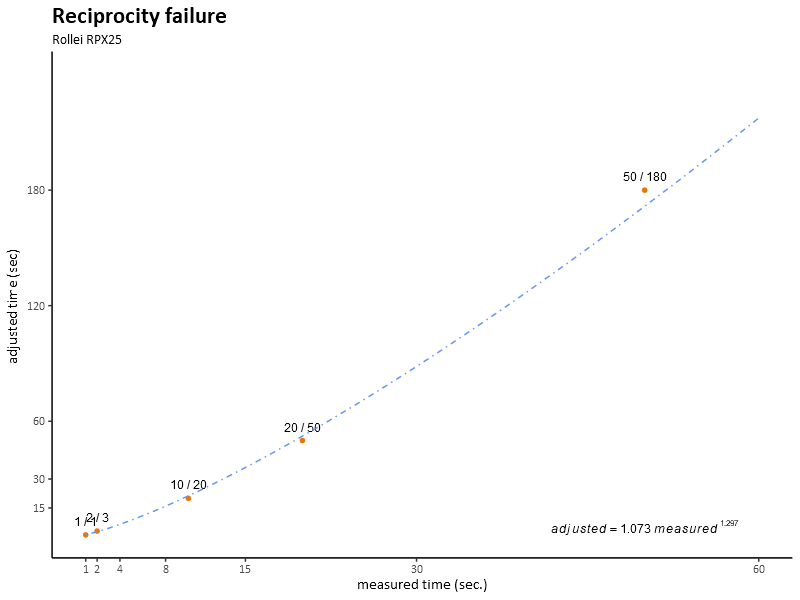I am on a lookout for a new film for my long exposure photography. When doing research on available slow films I came across the Rollei (Maco) RPX 25. I liked the specs of the film, and I was greatly impressed by its close cousin, the Rollei Infrared.
For some time I have used Foma 100 as my go-to long exposure film. Firstly for its low, low price, and secondly for its very high reciprocity failure. Usually a high reciprocity failure is thought of as an weakness. Films showing less of a failure – such as Fuji Acros – are preferred. But in the special world of long exposure photography a bad reciprocity failure is actually an asset. You get two extra stops of light loss for free! However, I have recently experienced quality issues with the Foma film and started looking for other options.
One issue I found with the RPX 25 film is that the published reciprocity failure is quoted only for 4 times: 2, 10, 20 and 50 seconds. Of these the 10, 20 and 50 second times are outside the usual sequence of exposure times. This was a problem to me, as with such a slow film I expected to run into reciprocity failure areas quite often. Both on purpose, shooting with heavy ND filters, and unintentionally in low light.
To make sense of it I tried modelling the exposure times in my trusty RStudio statistical package. I tried several different regression algorithms and settled on a power regression. This seemed to fit the data better than an exponential. I was able to model a function that matched the reported times closely. The biggest difference is about 4% off at the 50 second data point, and I can live with that.
Rollei RPX 25 Reciprocity Table (modeled)
| measured: | 0:01 | 0:02 | 0:02 | 0:03 | 0:04 | 0:06 | 0:08 | 0:12 | 0:15 | 0:20 | 0:30 | 0:45 | 0:50 | 1:00 | 1:30 | 2:00 |
| adjusted: | 0:01 | 0:02 | 0:03 | 0:04 | 0:06 | 0:11 | 0:16 | 0:27 | 0:36 | 0:52 | 1:28 | 2:30 | 2:52 | 3:37 | 6:08 | 8:54 |


So does Rollei have RF table that they can provide for different timing over 60 seconds
Up to 20 minutes???
I like to shoot day time or around sunset and I use 10 stopper and polarizer and 2 stops and ND filters to get long exposure
I normally use Fujifilm velvia 50 transparency color slides and I use fujifilm RF time table
Do you think that Rollei Ortho supper 25 will , react the same as with fujifilm 50 ???
I have observed that the reciprocity failure is a simple physical process, and as such can be modeled with a reasonable accuracy. The curve will of course be different for different emulsions, but once modeled it is usually accurate (if in doubt, bracket).
Have a look at the app over here: http://www.jla-analog.net/reciprocity-failure-calculator/ – it is interactive, with default values entered from Ilford datasheets, but user editable. If you replace the defaults with data points from Rollei Ortho or Velvia 50 datasheets it will calculate the curve automatically, and supports saving the data in csv format.
Many films reasonably follow a characteristic power curve for reciprocity. I keep them in my phone as it is a simple calculation to do on the spot. I rate RPX25 the same as Ilford PanF – after 1 second, the value in seconds to the power of 1.33 is close enough. 10 goes to 21, 20 goes to 54, 50 goes to 181.
Given you have just three data points from sheet and no indicated basis of calculation, you may have to resort to experiment.